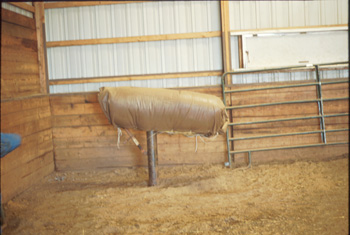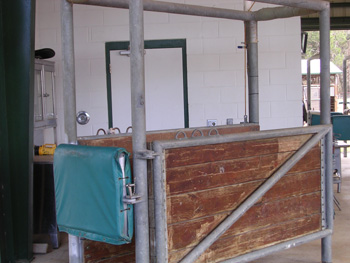Farms Using Artificial Insemination
Most farms using artificial insemination will have at least two pieces of equipment: a phantom and insemination chute.
Phantom
The use of a mare phantom or “collection dummy” removes the need for a mare during semen collection. Once trained, stallions will serve the A.V. while mounted on the phantom. Phantoms are padded cylindrical tubes positioned above the ground with one or two pipe legs.
Phantom dimensions vary between farms; however, most are between 5 and 8 feet long and 4 to 5 feet in circumference. A commonly expressed disadvantage with the smaller circumference phantoms is that the stallions have difficulty stabilizing on the phantom when serving the A.V. Phantoms with diameters on the larger end of the range may be difficult for some stallions to grasp with the front legs.
One modification on the smaller cylindrical tube design has been to increase the circumference on the rear two feet of the cylinder. This design allows for the stallion’s front legs to grasp a small diameter cylinder while allowing his body to rest on the larger portion. Another modification involves a cutaway along the side or under the rear of the cylinder to allow for positioning of the A.V.
Phantom cylinder construction commonly uses an 8- to 10-inch diameter metal core constructed from pipe or heavy gauge sheet metal frames. The phantom is positioned above the ground on 3- to 4-inch pipe legs that are anchored securely in the ground. The legs need to be designed to allow for height adjustment on rear and front. Heights will vary depending on the stallion. The top of the front of the phantom is commonly raised about 5 feet from the ground. Rear heights typically are about a foot lower.
An added feature for height adjustment uses an upper pipe of small diameter designed to slide inside a lower pipe, which is anchored into the ground. To secure heights, aligned holes are drilled in each pipe every 6 inches to allow a metal pin to be inserted through both pipes. Use of a 1/2- to 1-inch set screw housed in the lower portion of the lower leg provides further stabilization of the phantom.
Metal cores and legs are covered with a minimum of 8 to 12 inches of foam padding and covered in nylon-reinforced vinyl or some other nonabrasive material, such as leather. The covering must be easily cleaned with water and disinfectant. Addition of a leather simulated “mane” positioned at the front third of the phantom allows the stallion to grip the “mane” with his teeth, further stabilizing himself while mounted.
Stanchions
Stanchions are used for many purposes on horse farms: washing, grooming, injury treatment, and breeding. Relative to the breeding activities, stantions are used for teasing, washing, palpation and examination of stallions and mares. Stanchion construction must consider the large potential for horse and handler injury in and around the stantion. Sharp edges and projecting structures should be avoided.
Stanchions used for mature horses typically are constructed from 3- to 4-inch pipe frames. Length dimensions are approximately 5 1/2 to 6 feet, and internal widths range from 26 to 32 inches. Height from top of stanchion to the ground should be 7 to 8 feet. Sides are constructed with one or more side rails. Sides may also be solid metal or wood. Single-railed side bar heights should be approximately 3 1/2 feet from the ground. Double-railed side bar heights should be approximately 3 and 4 feet from the ground.
Solid sides are also suitable. Sides can be hinged to swing out at the front or rear or have sliding or hinged windows to allow access to specific areas of the horse’s body for examination. Foal stanchions designed to house foals along side mares should have solid sides that are at least 3 feet 6 inches in height. Taller sides may better deter any attempts of the foal to jump out of the stanchion.
Rear door heights should allow for ease of palpation and insemination, but should be tall enough to deter mares from kicking above the top of the door. The preference for the amount of clearance beneath the door and actual door height varies between individual managers. The top of the door should reach 3 feet to 3 feet, 3 inches above the floor. Bottom door clearance of 1 to 6 inches should protect the examiner from being kicked.
A front gate placed to a top height of 3 feet, 6 inches can assist in containing unruly mares. However, a cotton chest rope is routinely used instead of a front door. The use of a rope allows for adjustment forward and backward, thus allowing the mare’s hindquarters to be positioned against the rear gate for palpation and insemination.
Stanchions used for palpation and insemination will need an accessible water source at the rear. Faucets and plumbing should be protected from horse traffic. Some stanchions are designed with plumbing along the top rail of the rear of the stanchion, with faucet placement on the side of the rear frame 6 to 7 feet above the floor.
Small brackets or shelves on the rear of the stanchions designed to house soaps, paper towels, and other supplies provide easy access for the examiner. These structures should be positioned away from horse traffic in and out of the stanchion.
Breeding Laboratory
Semen collection and evaluation equipment is housed in a breeding laboratory. Laboratories should provide a dust-free, clean environment and be conveniently located near the breeding shed. The laboratory will need a hot and cold water source in addition to housing space for microscopes, semen incubators, and collection and insemination equipment. Many farms find it useful to house on-farm medication supplies requiring refrigeration or controlled dispensing in the breeding laboratory. A useful design of a laboratory allows for observation into the breeding shed area by a window so the laboratory technician can coordinate with the horse handlers and semen collection and insemination personnel.





